Perusing the PlayerProfiler Depth Charts, we are looking for sleeper breakout candidates that no one is talking about, particularly ESPN’s Mike Clay, who recently listed his Top 2017 Fantasy Breakout for Every NFL Team. Sometimes, it feels like Mike Clay has been sent from the future to usurp every original article premise. The Clay 1000 unleashed his breakout player takitude on the fantasy community like a rodeo bull on January 4th. I swear that I had a similar article premise percolating. Too late.
I cannot run from the past. I cannot hide from the future. Though unable to match the Clay’s article writing speed and efficiency (and proficiency), I remain committed to rage against the machine. I will not pivot to an alternative premise. No. I will write a competing Top 2017 Fantasy Breakout for Every NFL Team piece. I will rise up with deeper, edgier alternatives while staying even truer to the original premise, short circuiting the Clay 1000’s programming.
Because timeliness was no longer a consideration, I allowed this topic to marinate rather than microwaving an article just to be the first bull out the door. To write the piece, I selected four players per week and posted video logs (vlogs) explaining my article writing process to RotoUnderworld Radio supporters. Become an Official RotoUnderworld Patron to access the vlog.
Here are 32 alternative breakout sleepers from each team juxtaposed with a machine-generated alternative:
Arizona Cardinals
J.J. Nelson (WR) vs. Jaron Brown (WR)
Bye Michael Floyd. Bye Larry Fitzgerald? Bye John Brown? Is J.J. Nelson #good?
The New England Patriots signed Michael Floyd after he was cut by the Arizona Cardinals following a DUI arrest, demonstrating the callousness of the NFL. As an unrestricted free agent this offseason, the Cardinals will surely not be offering Floyd a contract to return to Arizona.
Larry Fitzgerald posted a mere two top-24 WR performances after week 10 and is seriously considering retirement after sputtering to close a season for the second consecutive year.
John Brown‘s pervasive hamstring ailment haunted him through the 2016 season. With Brown’s future playing status now shrouded in uncertainty, the Cardinals promoted J.J. Nelson to take over Brown’s field stretching role on offense.
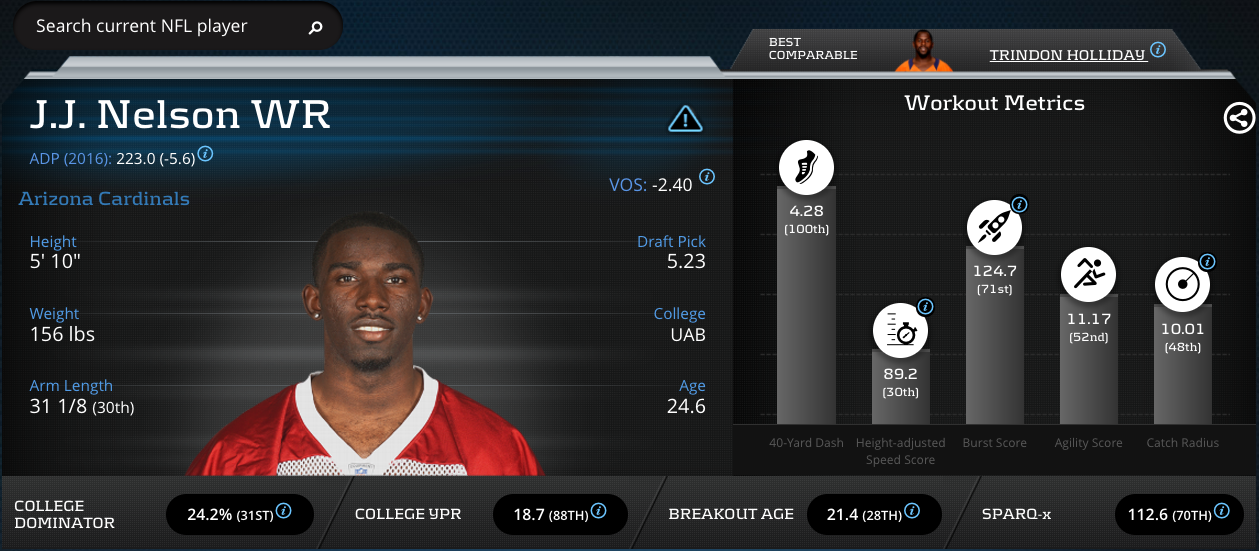
J.J. Nelson Advanced Stats & Metrics Profile
It would be a stretch to call J.J. Nelson a “breakout” candidate after five consecutive double-digit fantasy performances to finish out 2016. No fantasy footballers with access to box scores are sleeping on J.J. Nelson, but those with PlayerProfiler would question his efficiency. Nelson’s 44.9-percent catch rate was league bottom, and his 7.0-percent drop rate (drops per target) ranked among the highest in the NFL. Furthermore, the 37-year old Carson Palmer‘s, deep ball accuracy (22.4-percent) cratered in 2017 after complaining of dead arm. What could be a worse fit than a field stretching deep threat paired with an aging dead-armed quarterback?
This tour through the flawed characters in the 2016 Cardinals passing game terminates at the feet of a true sleeper breakout candidate: Jaron Brown. Brown is athletic as evidenced by a 119.4 (87th-percentile) SPARQ-x Score. Brown received 3.8 targets per game (impressive for any team’s No. 5 WR).
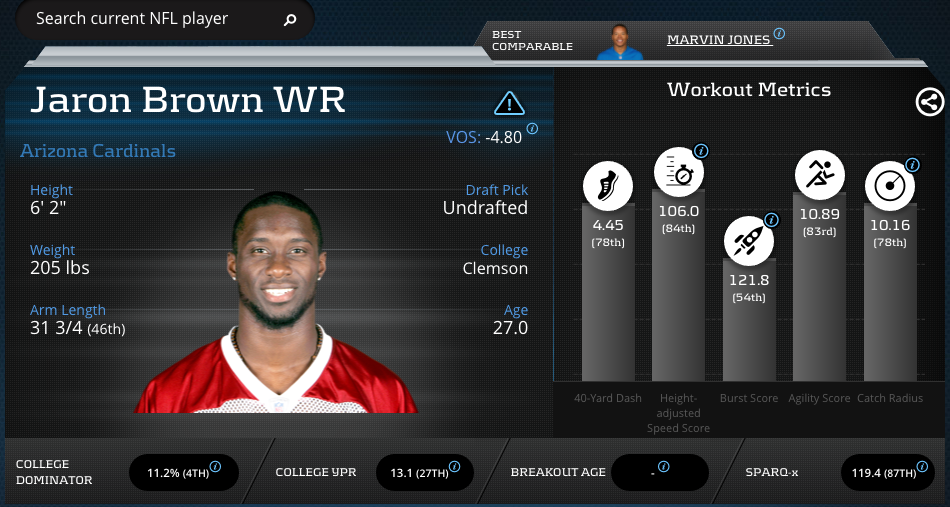
Jaron Brown Advanced Stats & Metrics Profile
While Jaron Brown possesses the size and speed to operate on the perimeter, during his time in Arizona, he has predominantly played a slot-flanker possession receiver role. While his catch rate was below 50-percent in 2016, Brown posted a robust 5.8 air yards per target and an impressive 17.0 yards per reception last season. Jaron Brown‘s athleticism offers a similar ceiling to John Brown and J.J. Nelson while possessing the size and versatility to achieve a higher target share in 2017, and therefore, more reliable weekly fantasy production.
Atlanta Falcons
Austin Hooper (TE) vs. Taylor Gabriel (WR)
Austin Hooper is a great choice. Hooper’s +33.0 Production Premium and 10.0 yards per target made him one of the NFL’s most efficient tight ends in 2016 at just 22-years old.
With Austin Hooper off the board, Taylor Gabriel is a more contrarian breakout candidate. What if Gabriel’s 2016 flashes were not an aberration? The diminutive-yet-explosive Gabriel is arguably more athletic than Jaron Brown and more efficient. Featuring a +56.1 (No. 1) Production Premium and 11.5 (No. 2) in yards per target, Gabriel is the perfect big-play field stretcher opposite Julio Jones whose target depth projects to decline after passing the WR age apex and sliding into the back half of his career.
Baltimore Ravens
Kenneth Dixon (RB) vs. Breshad Perriman (WR)
Kenneth Dixon demonstrated both big play ability and elusiveness as a rookie, evidenced by a 6.8-percent (No. 11) Breakaway Run Rate and 32.2-percent (No. 6) Juke Rate in 2016. Assuming the Ravens do not draft a running back in the early rounds of the 2017 NFL Draft, Dixon projects to garner a 60-percent Opportunity Share in a every-down, bell cow role. Dixon is an exciting young player, but after posting five double-digit fantasy performances in the second half of the season, he is no longer a sleeper.
While the fantasy community is woke to Kenneth Dixon, most analysts are still sleeping on Breshad Perriman after he garnered only a handful of weeks with a snap share over 50-percent and one week with more than 15 fantasy points. Perriman’s measurables indicate he could be the heir to Julio Jones as the NFL’s premiere size-speed specimen with a 125.7 (99th-percentile) Height-adjusted Speed Score (HaSS).
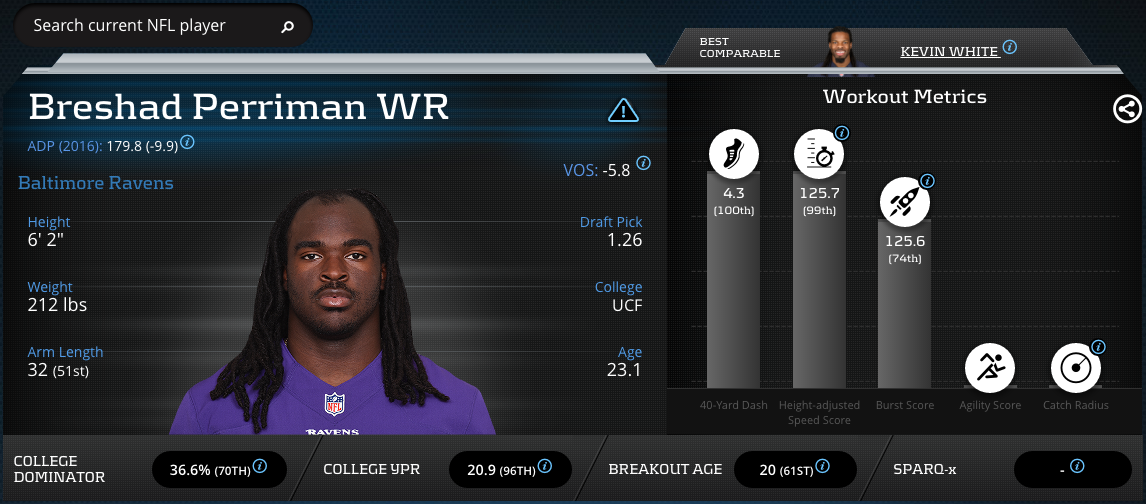
Breshad Perriman Advanced Stats & Metrics Profile
Breshad Perriman is a proper outside X-receiver, evidenced by a 20.9 college yards per reception and negligible slot snaps in 2016 who is poised to assume Mike Wallace‘s 117 targets from 2016. With Steve Smith retired and Mike Wallace possibly departing Baltimore after salvaging his career with a one-year contact, Kevin McHugh believes Breshad Perriman could conceivably be the number one receiver to open 2017 on a team that called 43.7 pass plays per game, No. 3 in the NFL. Based on his rare talent profile and projected opportunity boom, Perriman possesses the most upside of any late-round wide receiver.
Buffalo Bills
Jonathan Williams (RB) vs. Logan Thomas (TE)
Sniped again. Jonathan Williams became an intriguing LeSean McCoy handcuff for 2017 after he posted a 10.26 (55th-percentile) Agility Score at the NFL Scouting Combine, displaying excellent lateral quickness for a 220-pound back.
https://www.youtube.com/watch?v=40ziNIoRwrA&t=2s
The other interesting breakout sleeper candidate on the Buffalo roster is Logan Thomas. Like Eric Swoope, Thomas is another no-cost upside tight end play for 2017. Thomas arrived at Virginia Tech as the No. 1 high school tight end recruit before switching to quarterback in college. Most players switched from quarterback to another skill position at the college level. Rarely do skill position players become quarterbacks.
Logan Thomas‘ athletic profile and innate football instincts offers hope that the transition to tight end will be less perilous. Unlike former basketball players like Swoope and Demetrius Harris, Thomas’ positional learning curve is less steep. Learning tight end blocking assignments and technique will be more like getting back on a bicycle than learning how to ride a unicycle.
Carolina Panthers
Devin Funchess (WR) vs. Keyarris Garrett (WR)
Devin Funchess is the only reasonable selection. How do we dig deeper? Go to the PlayerProfiler Depth Charts. The depth charts include practice squad and players signed to futures contracts. The Panthers’ shallow roster is largely devoid of skill position depth, but one player offers significant intrigue: Keyarris Garrett.
Keyarris Garrett led the NCAA Division 1 wide receivers in receiving yards as a fifth-year senior at Tulsa. His stature and workout metrics align surprisingly well with Dez Bryant. Signed by Carolina as a UDFA, Garrett was an awful fit on a team already featuring two 6-4 monsters of the midway at WR. Garrett is one of the few gems unearthed by Dave Gettleman, but in true Panthers form, the team inexplicably refused to elevate Garrett after placing Funchess on injured reserve in December.
https://www.youtube.com/watch?v=I2mxKofmkBY&t=7s
If Keyarris Garrett flashes in training camp, he merely must supplant Brenton Bersin or Ted Ginn or Corey Brown to win a roster spot, assuming the Panthers do not invest early round draft capital in the wide receiver position again in 2017 (many draft experts suggest running back is a greater need).
Chicago Bears
Kevin White (WR) vs. Ben “Bronk” Braunecker (TE)
Kevin White is a bust. Bad decisions made by NFL front offices have lasting effects in fantasy football as fantasy enthusiasts often struggle to come to terms with the NFL’s scouting industrial complex’s fundamental flaws. Years after a highly graded player was overdrafted, fantasy gamers continue to overvalue the initial draft capital investments, and few draft picks were more misguided than those of Kevin White. White posted a -32.2 Production Premium and a -36.7-percent Target Premium, the most inefficient WR season in PlayerProfiler history. He is simply not the explosive playmaker that NFL scouts thought their eyes were seeing.
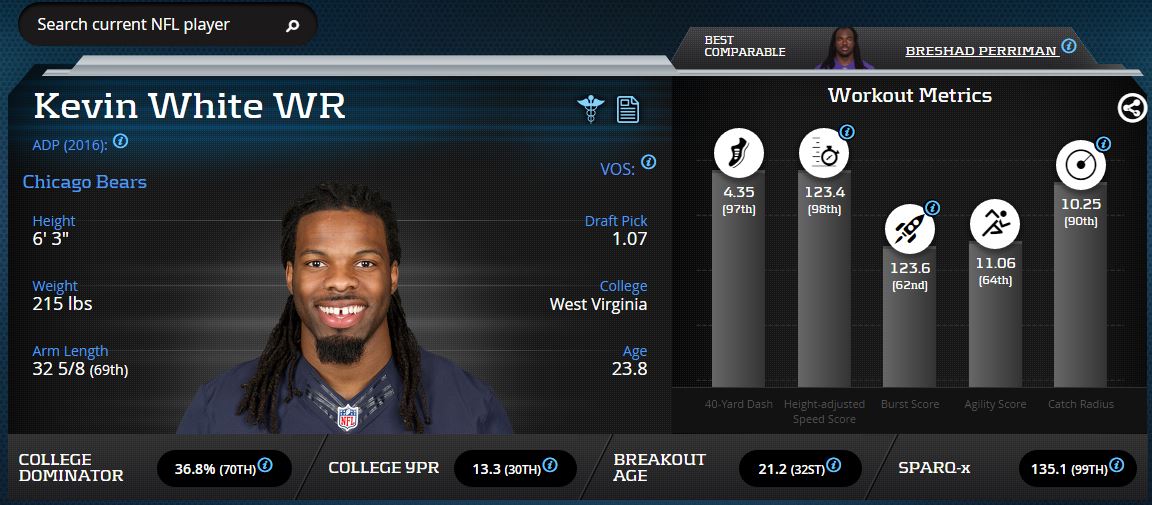
Kevin White Advanced Stats & Metrics Profile
Cameron Meredith is the true No. 1 WR for Chicago. With the Bears likely moving on from Jay Cutler and trapped in QB purgatory, it would be difficult to support more than one fantasy-viable wide receiver in 2017.
Kevin White: The most inefficient wide receiver in PlayerProfiler history.https://t.co/YqWVC2cGdu pic.twitter.com/ZxcgpoWXpJ
— RotoUnderworld (@rotounderworld) January 27, 2017
Rather than delving into the wide receiver depth chart, Ben “Bronk” Braunecker is an interesting sleeper tight end. Zach Miller is 32-years old and Daniel Brown lacks the size to assume more than move tight end duties. Bronk, on the other hand, has the size and explosiveness to fill Zach Miller’s shoes sooner rather than later given the NFL’s history of extreme tight end injury rates.
https://www.youtube.com/watch?v=Yj7EziNj2Qo
Cincinnati Bengals
Tyler Boyd (WR) vs. Rex Burkhead (RB)
Tyler Boyd looks like the future at the wide receiver position for the Bengals based on an extraordinary college resume featuring a 42.7-percent College Dominator Rating and 18.8 (92nd-percentile) Breakout Age.
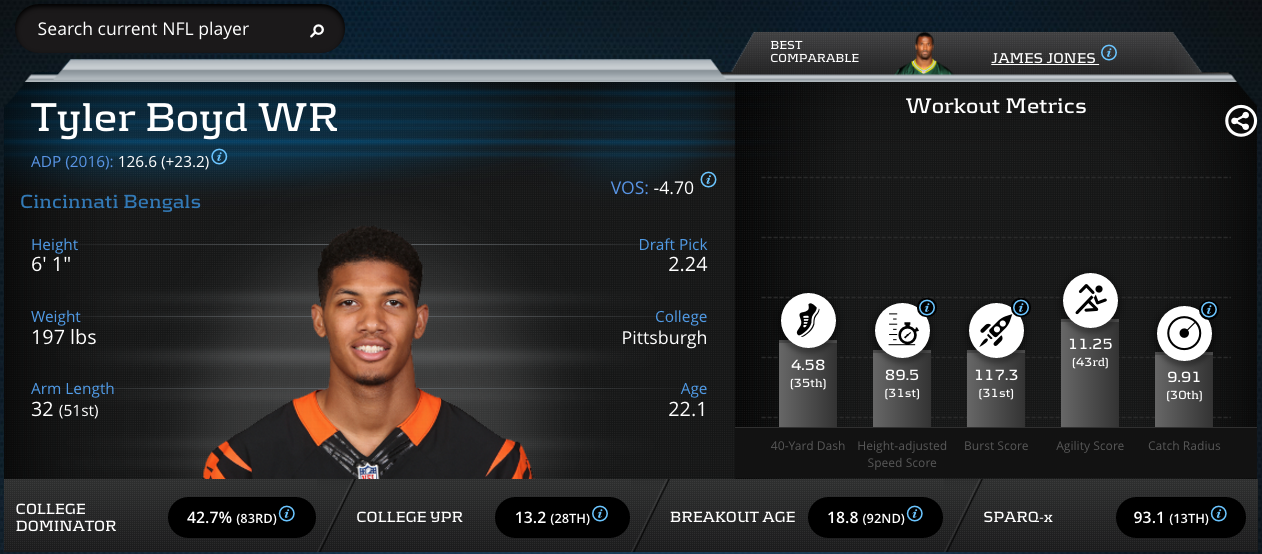
Tyler Boyd Advanced Stats & Metrics Profile
Fortunately, Rex Burkhead looks like the future of the running back positions for the Bengals after closing out 2016 with 144 total yards and two touchdowns. Burkhead’s top-12 Juke Rate and top-12 catch rate put him in select RB efficiency company in 2016 as he showed off true bell cow back traits for Cincinnati. Burkhead is objectively better at the sport of football than Jeremy Hill and heads into the offseason as the team’s every-down running back while Giovani Bernard rehabilitates a torn ACL.
https://www.youtube.com/watch?v=cTbFYeXYKgY
Cleveland Browns
Corey Coleman (WR) vs. Darius Jackson (RB)
Another first round wide receiver? Did wide receiver guru Matt Harmon commandeer Clay’s control panel? Indeed, it feels anti-climatic to tout first round pick Corey Coleman as a post-hype sleeper heading into the 2017 season after Clay projected Coleman to post 75 receptions as a rookie despite being tethered to Robert Griffin III and Cody Kessler.
Early 2016 Browns WR Corey Coleman projection: 75 receptions, 992 yards, 4 TD (Fringe WR3)
— Mike Clay (@MikeClayNFL) April 29, 2016
Darius Jackson is lesser known, but equally intriguing, and is a close comparable to Ben Tate. Kevin Cole from RotoViz explains that athleticism matters more for running backs than other skill position players. Jackson has athleticism to burn.
![[Darius Jackson]-Running Back-Cleveland Browns]](https://www.playerprofiler.com/wp-content/uploads/2016/12/darius-jackson.jpg)
Darius Jackson Advanced Stats & Metrics Profile
Dallas Cowboys
Dak Prescott!?!? (QB) vs. Cole Beasley (WR)
Little-known quarterback Dak Prescott is a 2017 breakout candidate. Huh?
https://www.youtube.com/watch?v=KX2MPI6jp4A&t=1s
In the history of second-year players, 2016 fantasy QB1 Dak Prescott is about the farthest thing from a fantasy football sleeper. It would be nice to find an under-the-radar name on the Cowboys roster, but at 27 years old, all Brice Butler enthusiasm is extinguished, and Gavin Escobar is never going to be a thing. That leaves Cole Beasley who still narrowly qualifies for sleeper status and is the clear choice through on process of elimination.
In 2016, Cole Beasley soaked up targets at a 76.5-percent catch rate (No. 3 among NFL wide receivers). With strong hands on an undersized frame, Beasley looks like a sneaky-explosive Wes Welker demonstrated by his 127.6 (81st-percentile) Burst Score.
As Dak Prescott continues to develop and improve, the Cowboys will assuredly call more pass plays in 2017. Many of these targets will be funneled to Cole Beasley as Jason Witten plays out his final days in the NFL and 2016 starting WR Terrance Williams is unlikely to re-sign with Dallas in 2017. Efficiency + Opportunity = Fantasy Football Breakout.
Denver Broncos
A.J. Derby (TE) vs. Devontae Booker (RB)
A.J. Derby‘s profile is devoid of any special traits. Derby is the quintessential just a dude-guy tight end and a long-shot to return fantasy TE1 numbers at any point in his career.
Meanwhile, Devontae Booker is a free square! Booker was a dominant college runner and deserves an opportunity to seize the primary back role after C.J. Anderson has underwhelmed for two-straight seasons. Since Anderson’s epic 8-game run in 2014, when his fantasy production was second only to Le’Veon Bell, his efficiency collapsed, evidenced by consecutive sub-zero Production Premiums in 2015 and 2016.
https://www.youtube.com/watch?v=9-R_IUCycU0
On the other hand, Devontae Booker demonstrated fluidity in space going back to his days as a dominant workhorse back at Utah. Booker offers primary back size, and bell cow durability, evidenced by a 40.1-percent (87th-percentile) College Dominator Rating and is a true passing game dynamo as evidenced by a 14.3-percent (91st-percentile) College Target Share. During his brief stint as Denver’s primary ball carrier, Booker flashed trustworthy hands and route running prowess allowing him to be more active in the passing game, and therefore, more efficient on a per-touch basis than plodding grinder C.J. Anderson. Devontae Booker is the sneakiest high ceiling sleeper running back heading into 2017.
Detroit Lions
Ameer Abdullah (RB) vs. T.J. Jones (WR)
Mike Clay nailed it. Ameer Abdullah is slam dunk breakout candidate in 2017 after 37.1-percent College Dominator Rating (80th-percentile) at Nebraska before shredding the NFL Scouting Combine on his way to posting a 138.7 (98th-percentile) SPARQ-x Score. Like Breshad Perriman, Abdullah’s athleticism makes him one of the highest ceiling players on any roster. And like Perriman, the fantasy football community’s enthusiasm for Abdullah is suppressed after he missed more than half of the 2016 season with a severe foot injury.
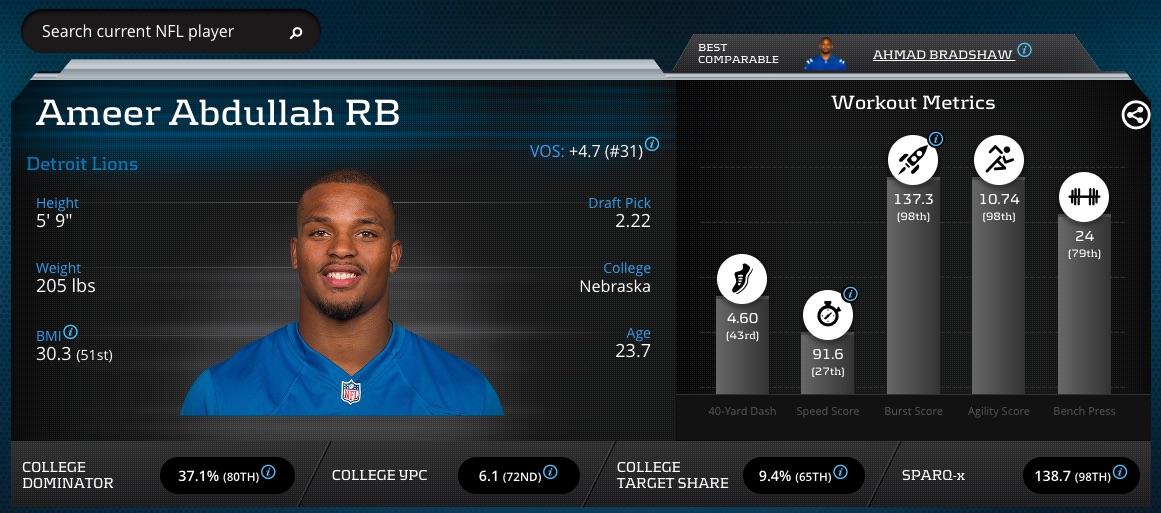
Ameer Abdullah Advanced Stats & Metrics Profile
If not Ameer Abdullah, who? The Detroit Lions depth chart is a barren wasteland of non-sleepers. However, T.J. Jones is not dead yet and deserves a lukewarm tout. While Jones profiles as an NFL slot receiver, that is not necessarily a drawback. Anquan Boldin was near the top of the league in routes run out of the slot and red zone usage after Boldin achieved a 26.7-percent red zone target share in 2016.
Highest WR slot rates:
1. Shepard
2. Boyd
3. Landry
4. Baldwin
5. Kerley
6. Crowder
7. Boldin
8. Enunwa
9. Beasley
10. Fitzgerald pic.twitter.com/RingXU3WIs— RotoUnderworld (@rotounderworld) January 31, 2017
T.J. Jones caught 9 touchdowns and posted an impressive 15.8 yards per reception in his final year at Notre Dame. Jones’ late Breakout Age indicates he is still a long shot to play heavy snaps in the NFL, but if given an opportunity, he could carve out a significant role in the Lions high-volume offense and become a consistent weekly fantasy football contributor.
Green Bay Packers
Ty Montgomery (RB) vs. Jeff Janis (WR)
Ty Montgomery is another great choice. At 6-0, 216-pounds, Montgomery is built like a running back, not a wide receiver, which Lance Zierlein noted in Ty Montgomery‘s predraft scouting report for NFL.com. Most fantasy gamers are still adjusting to Montgomery’s position shift, but the Packers, Mike Clay, Lance Zierlein, and Matt Kelley know that he was born to play running back. After posting an exceptional 5.9 yards per carry last season, Montgomery possesses the stature and spacial awareness to be Theo Riddick 2.0 and Green Bay’s primary back of the future.
https://www.youtube.com/watch?v=w1MklKAk9hM
My choices begin and end with Jeff Janis, and I stand by every word of my 2016 preseason Janis hyperbole: The Great Hype Void: Jeff Janis Chases a Fickle American Dream.
Houston Texans
Will Fuller (WR) vs. Wendall Williams (WR)
Have you noticed a theme? If a team drafted a wide receiver in the first round and he face-planted in the year 1-2, that player is often penciled in as a breakout candidate. Who’s next, Nelson Agholor?
Unfortunately, first round disappointment is more likely than success for wide receivers, and Will Fuller looked like just another first round bust in 2016. Fuller’s -17.3 Production Premium, PlayerProfiler’s field position and game situation-agnostic efficiency metric, checked in at No. 90 last season. Fuller’s 6.8 (No. 76) yards per target were a product of Brock Osweiler‘s inaccuracy and Fuller’s inability to secure the football, evidenced by a 7.0-percent (No. 12) Drop Rate. The catch point challenges Fuller faced at Notre Dame are now haunting him at the professional level.
DeAndre Hopkins is the undisputed target hog for a Houston Texans team that will struggle to sustain more than one fantasy-viable wide receiver with Brock Osweiler under center. If we are throwing speculative darts at WRs that require some depth chart upheaval to ascend, why not chase the wide receiver with the most upside: Wendall Williams.
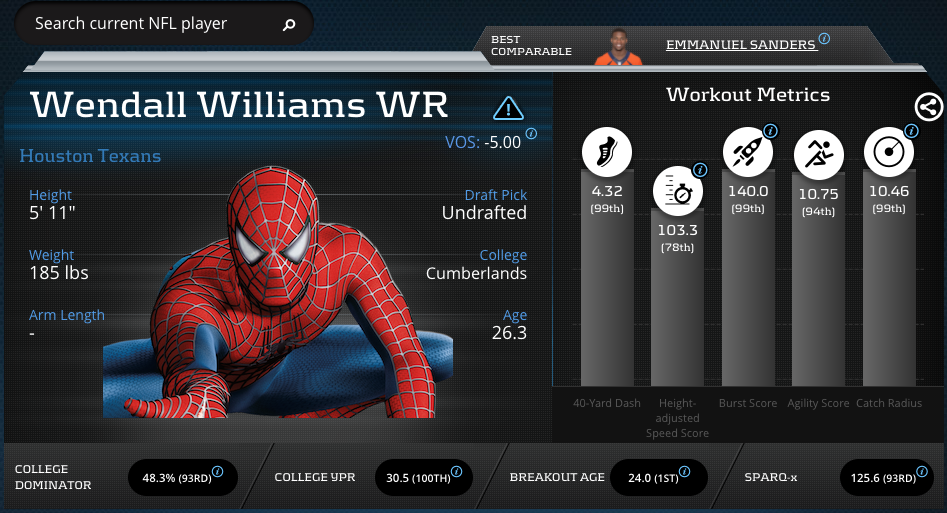
Wendall Williams looks like a more athletic Emmanuel Sanders in a vacuum. A college basketball player that was deemed too small to make the NBA, Williams decided to follow the Chris Hogan career path and become a professional football player relatively late in life. Boasting superhero measurables, Williams went to Cumberlands College where he posted the highest yards per reception in the PlayerProfiler database. In his few on-field opportunities in 2016, Williams also posted a positive Production Premium and Target Premium. If afforded an opportunity to start opposite DeAndre Hopkins, Williams could be the outside playmaker Houston hoped Will Fuller would become.
https://www.youtube.com/watch?v=xunRb7rLCxQ
Indianapolis Colts
Donte Moncrief (WR) vs. Eric Swoope (TE)
Wait, Donte Moncrief qualifies for sleeper status? Fantasy footballers are asleep on Donte Moncrief after two straight years of double-digit fantasy point production? Rather than sleeping on Moncrief, I believe fantasy gamers so-so woke to Donte Moncrief, that he will be over-drafted in 2017 as an explosive-size-speed-specimen-tethered-to-Andrew Luck narrative (that I initiated) continues to gather momentum.
https://www.youtube.com/watch?v=nd6DYirDQN4
In 2016, Donte Moncrief was the quintessential TD-dependent wide receiver securing 8 red zone receptions (No. 27 among NFL WRs) on a mere 30 total receptions (No. 91 among NFL WRs). A 26.7-percent red zone reception rate is exceptionally high even for a starting NFL wide receiver on a prolific offense. Despite unusually high red zone usage, Moncrief has yet to ascend to fantasy WR2 status through his 3-year career catchings passes from Andrew Luck due primarily to perennial inefficiency outside the red zone.
*2014 Catch Rate: 65.3-percent
*2015 Catch Rate: 61.0-percent
*2016 Catch Rate: 53.6-percent
donte moncrief total receptions: 30 (no. 91)
donte moncrief total red zone receptions: 8 (no. 27)
if 27% feels high, that’s b/c it is high. pic.twitter.com/GqkqFdw6ge— the podfather (@Fantasy_Mansion) February 19, 2017
While advanced metrics suggests Donte Moncrief‘s efficiency has regressed rather than progressed, over the course of his NFL career, Erik Swoope‘s stock is rising. Similar to Demetrius Harris, Erik Swoope is a converted college basketball player. And like Harris, Swoope made an impressive leap in 2016.
https://www.youtube.com/watch?v=PBI0ogp6yGI&t=3s
Asked to learn run blocking, pass blocking, and route running assignments, the tight end position is one of most difficult positions to master in all of sports. Yet, Erik Swoope jumped forward on what is typically an elongated development curve by securing a 33.2-percent snap share last season. Having learned many of the nuances of route running and blocking at the NFL level, Swoope is already converting his raw athleticism into on-field efficiency, evidenced by a +43.7 (No. 2) Production Premium and 13.5 (No. 3) yards per target in 2017. Heading into his age-25 season, Swoope is poised to supplant athletically underwhelming incumbents Dwayne Allen and free agent Jack Doyle as the Colts primary move tight end and perhaps usurp Donte Moncrief as Andrew Luck‘s favorite red zone target.
Jacksonville Jaguars
T.J. Yeldon (RB) vs. Chad Henne (QB)
T.J. Yeldon is clinging to stale draft capital after failing in spectacular fashion to become Jacksonville’s primary ball carrier in the absence of Chris Ivory in 2016. This breakout selection was particularly surprising after Yeldon posted a mere 2.9 (No. 93) yards per carry against base defenses last season, Clay’s pet running back statistic.

TJ Yeldon Advanced Stats & Metrics Profile
Lost on a dystopian offense was the emergence of Marqise Lee as a reliable playmaker. Posting up Lee opposite Allen Robinson allows the Jaguars to push Allen Hurns to the slot. Running routes out of the slot allows Hurns to leverage his strengths while masking subpar athleticism. Robinson at split end/X, Lee at flanker/Z, and Hurns at slot/Y represents an optimal talent configuration for one of the NFL’s most talent-rich wide receiver corps.
Blake Bortles was apocalyptic in 2016 evidenced by a 78.8 (No. 41) passer rating on a mere 6.8 (No. 31) yards per attempt. If Bortles’ mechanics and decision making continue to deteriorate in 2017, Chad Henne will be called upon sooner rather than later.
As a starting quarterback, Chad Henne would be an immediate upgrade over Blake Bortles. Furthermore, Henne would be propelled to high-end fantasy QB2 by the Robinson-Lee-Hurns triumvirate.
Kansas City Chiefs
Chris Conley (WR) vs. Demetrius Harris (TE)
Chris Conley has a sublime athletic profile, but do I really want to push my chips all-in on a back-up wide receiver tethered to a bad quarterback? No. Conley’s 130.8 (97th-percentile) SPARQ-x Score is exceptional, but a closer look at his workout metrics reveals an explosive vertical threat lacking lateral quickness. Conley’s workout metrics proportionally mimic impressive size-speed busts of the past from Robert Meachem to Charles Johnson to Cordarrelle Patterson. Examining Conley’s past production, he posted two double-digit weeks in two years with the Chiefs after underwhelming at Georgia, posting a 29.3-percent (47th-percentile) College Dominator Rating. Oozing explosiveness yet devoid of consistent production suggests Conley is a one-dimensional downfield threat who lacks the necessary nuance to be a weekly NFL starter at the wide receiver position.
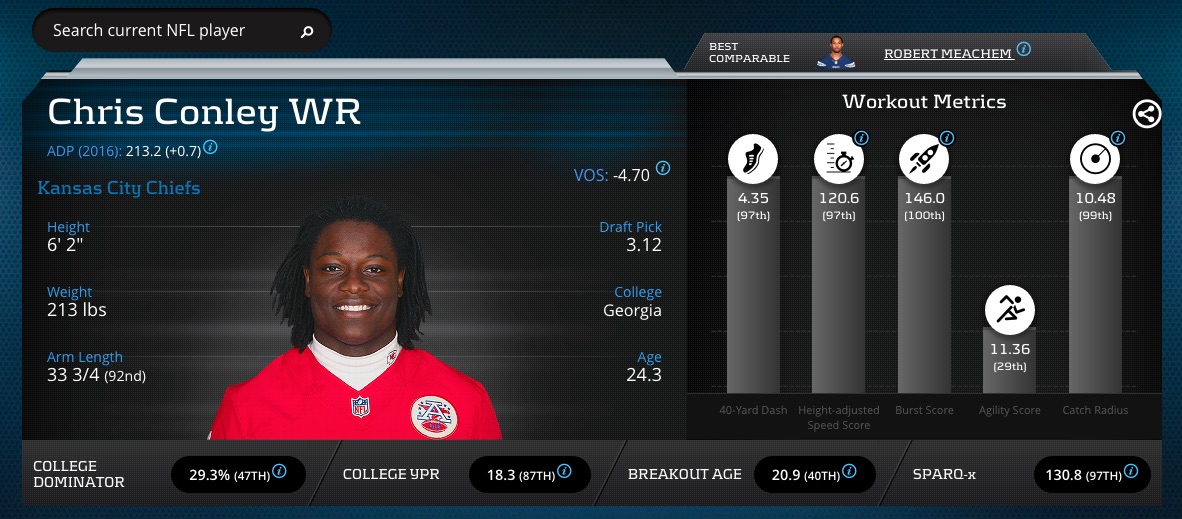
Chris Conley Advanced Stats & Metrics Profile
While Chris Conley‘s arrow is pointing down, Demetrius Harris‘ arrow is pointing up. Like Conley, Harris’ resume both oozes athleticism, after playing basketball at UW Milwaukee, and lacks consistent production. However, unlike Conley, Harris is one injury away from rising to No. 1 on the Chiefs positional depth chart. Moreover, tight end is the most injury-prone skill position, so the odds that Harris becomes a featured weapon in 2017 are higher than Conley.
https://www.youtube.com/watch?v=8Wyzc7mf1M8
Demetrius Harris is also relatively new to the position. Harris’ muted early-career usage was expected as he made the transition from basketball to football. Last year was a represented and encouraging step for Harris as he garnered close to a 50-percent snap share. On the other hand, Chris Conley was grossly inefficient, evidenced by a discouraging -13.1 (No. 82) Production Premium and -20.2 (No. 100) Target Premium. Conley’s no-show games in which Jeremy Maclin missed were particularly foreboding for his future NFL prospects. Meanwhile, Harris grew more comfortable with his route assignments and blocking technique as the season went on. In week 16, Harris received 9 targets, second on the team that week and more than Conley received in any given week last season.
Los Angeles Rams
Tyler Higbee (TE) vs. Pharoh Cooper (WR)
Am I being punked? I am supposed to believe Chris Conley, a No. 3 wide receiver on a low-pass volume who has never been dominant at any of football, is a legitimate breakout candidate? I can’t. I am supposed to believe Tyler Higbee, who posted an unimpressive 20.8-percent (65th-percentile) College Dominator Rating at Western Kentucky and a below-average 95.8 Height-adjusted Speed Score (HaSS) at the NFL Scouting Combine, can usurp 50-catch incumbent Lance Kendricks who is signed through 2018? I. Just. Can’t.
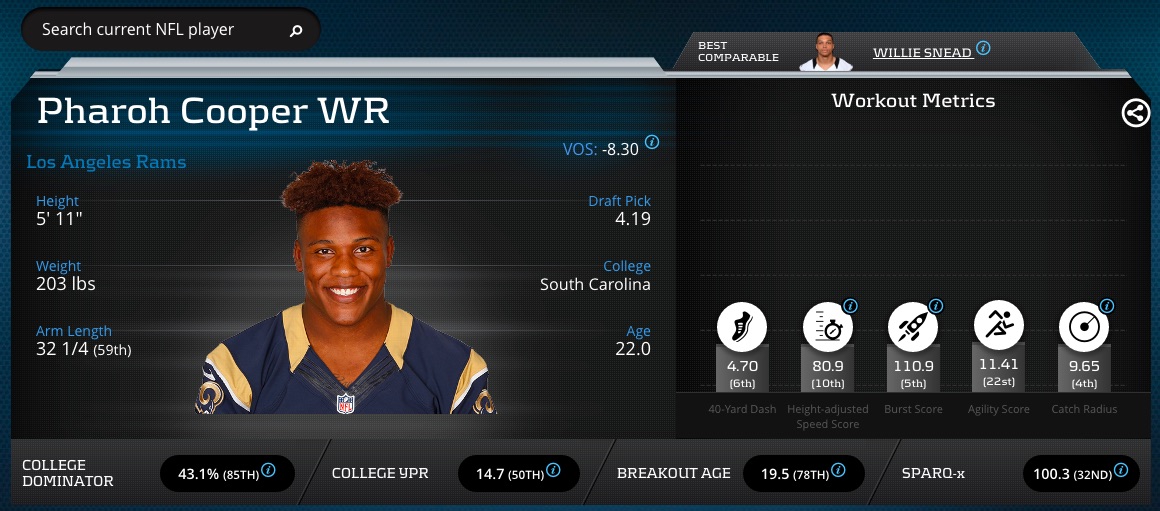
Pharoh Cooper Advanced Stats & Metrics Profile
Meanwhile, Pharoh Cooper is currently slated to open the NFL season as the No. 2 wide receiver on a low-pass volume, who was dominant at an early age at South Carolina, a power conference university, evidenced by a 43.1-percent (95th-percentile) College Dominator Rating and 19.5 (78th-percentile) Breakout Age. If the Rams do not draft a wide receiver in the early rounds of the NFL Draft, Cooper would lead the Rams in target share this coming season sharing a field with Tavon Austin, a notoriously inefficient gadget player. 120-plus targets could be in Cooper’s range of outcomes in 2017 as a volume slot/flanker featuring strength at the catch point reminiscent of Willie Snead. Operating as a target hog on a bad offense, Pharoh Cooper is the sleeper breakout candidate fantasy football enthusiasts need to know.
Miami Dolphins
Leonte Carroo (WR) vs. Kenyan Drake (RB)
Leonte Carroo is an excellent choice. Ability is not Carroo’s problem. He is oozing wide receiver talent, boasting a 63.9-percent (99th-percentile) College Dominator Rating, a 19.6 (74th-percentile) Breakout Age, 20.7 (96th-percentile) college yards per reception, and a 101.5 (73rd-percentile) HaSS. Carroo was the under-appreciated wide receiver prospect of the 2016 NFL Draft. His problem is offense, quarterback and depth chart.
Led by fearful game manager Ryan Tannehill, the Dolphins finished No. 31 in the NFL in total pass plays in 2016. In order to achieve fantasy relevance on an anemic pass offense, even a wide receiver as talented as Leonte Carroo would need starter’s snaps. Unfortunately, Carroo shares the field with 80’s action hero Jarvis Landry and rising star DeVante Parker. A former first round pick, Parker made a mini leap his sophomore season, eclipsing 50 receptions and 700 yards with above-average efficiency evidenced by a +9.5 (No. 31) Production Premium, 8.5 (No. 32) yards per target, and a 63.6-percent catch rate in 2016. Carroo’s 2017 breakout potential hinges on an injury to either an established or ascending star.

Leonte Carroo Advanced Stats & Metrics Profile
On the other hand, Kenyan Drake has a more straightforward path to fantasy relevance in 2017. While Jay Ajayi logged 1272 (No. 4) rushing yards as Miami’s defacto workhorse in 2016, Ajayi caught only 1.8 passes per game, an inordinately low number for a primary ball carrier.
The Dolphins drafted Kenyan Drake in the early third round in 2016 to be a high volume satellite back. Drake’s passing game dynamism deserves attention. His 9.0-percent (63rd-percentile) target share at Alabama was particularly impressive, because Derrick Henry dominated the RB touches during the majority of Drake’s tenure. Paired with Ryan Tannehill, one of the league’s premiere game manager QB, Kenyan Drake projects to make a leap in his second year in Miami’s system and dominate RB touches in the hurry-up offense and passing situations. Featuring a 107.1 (82nd-percentile) Speed Score, Drake could be “Theo Riddick South” this season, an electric satellite back who overshadows the team’s between-the-tackles grinder incumbent.
Minnesota Vikings
Laquon Treadwell (WR) vs. Teddy Bridgewater (QB)
Like Will Fuller and Corey Coleman, Laquon Treadwell is another snooze-worthy formulaic WR selection from the 2016 NFL Draft. First round pick in 2016 + underwhelming rookie year = cliche 2017 breakout. $100 bucks says Josh Doctson makes the list later on.
Unfortunately, like Leonte Carroo, Laquon Treadwell is trapped on a low pass volume offense with a fearful game manager at quarterback. Stefon Diggs is the established primary receiver in the Vikings passing game, and Adam Thielen emerged as an efficient No. 2 option in 2016. Furthemore, Thielen was arguably the most efficient WR in the NFL last season evidenced by a top-5 Production Premium, Target Premium, yards per target, and fantasy points per target. Given these headwinds, the notion that Treadwell could go from game day inactive in 2016 to supplanting Thielen as an every-down starter in 2017 reads like fiction.
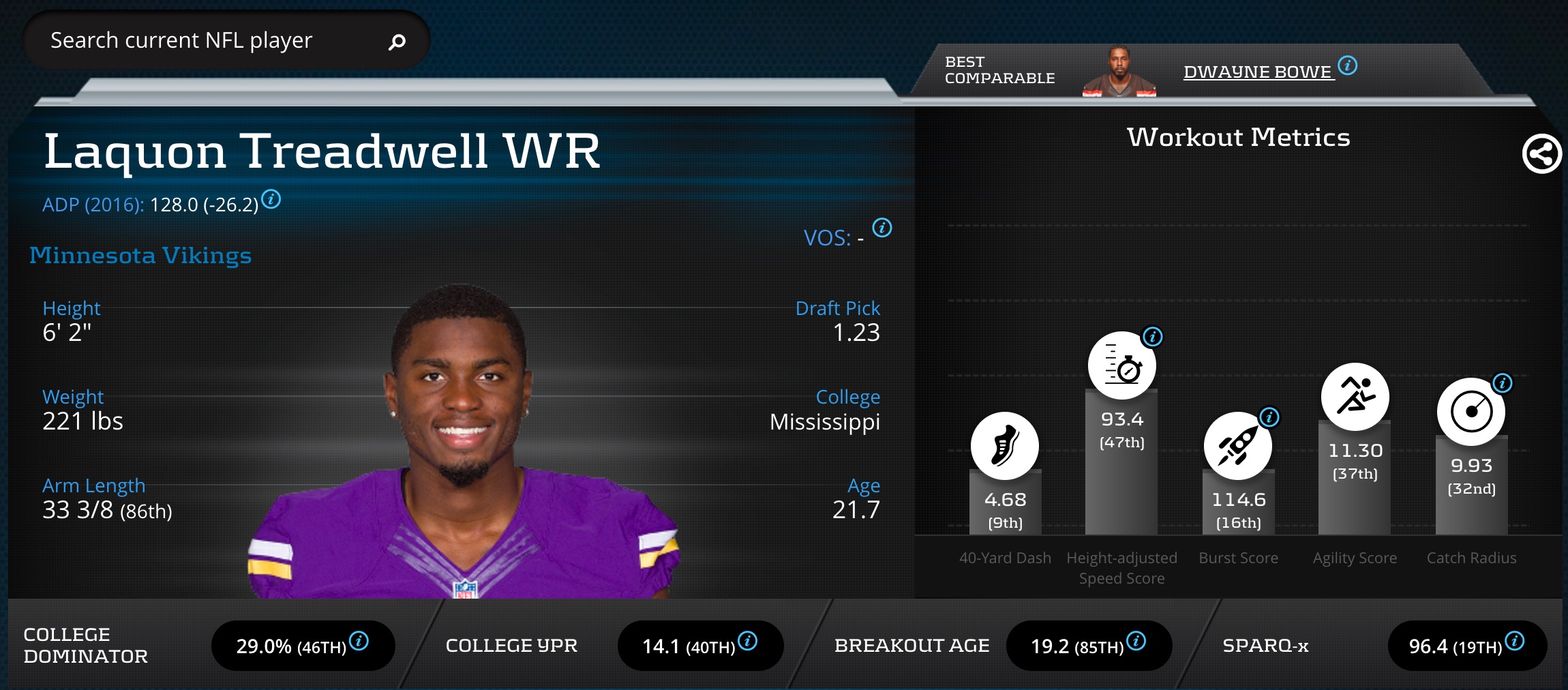
Laquon Treadwell Advanced Stats & Metrics Profile
After the young skill position core Stefon Diggs, Adam Thielen, Kyle Rudolph, and Jerick McKinnon all broke averaging 10 or more fantasy points per game in 2016, who could fantasy gamers possibly be sleeping on? Teddy Bridgewater.
Teddy Bridgewater‘s ascent began at age 22 when he posted a top-10 completion percentage and top-15 Total QBR. If he is able to return from a gruesome injury during a team practice last summer and leverage a more seasoned Vikings supporting cast, Bridgewater could conceivably become the most unlikely fantasy QB1 of 2017. However, “Insider buzz” suggests Teddy Bridgewater is likely to miss the 2017 season, but I am not so sure.
https://www.youtube.com/watch?v=dypBNtp5cZE&t=23s
Dennis Pitta‘s unexpected return to the Ravens in 2016 was a reminder that bones, tendons, and ligaments will heal if allowed the necessary time to recover. Few, if any, currently injured NFL player has more determination to play football at a high level than Teddy Bridgewater, who is famously single-minded about his craft. Doubting his ability to return to a football field in 2017 is not recommended.
New England Patriots
Malcolm Mitchell (WR) vs. Malcolm Mitchell (WR)
After predicting a Chris Hogan fantasy breakout throughout 2016, a breakout that never came to fruition until after the fantasy football season had concluded, I will not abide Malcolm Mitchell tout carpet bagging.
Kicking myself for not pushing ‘buy low’ on Hogan more this week. Guy is an every-down player in this offense.
— Mike Clay (@MikeClayNFL) October 9, 2016
I am taking back Malcolm Mitchell, the sleeper breakout take that is rightfully mine. After a productive true freshman season at Georgia, Mitchell’s college career was derailed by a torn ACL and diminished bad quarterback play. After posting well-above average speed and burst at the NFL Scouting Combine, Mitchell’s college resume and physical measurables compared favorably to Reggie Wayne and Jeremy Maclin. Fitting nicely the volume NFL flanker prototype, Malcolm Mitchell was one of the best-value wide receivers in the 2016 NFL Draft.
After an efficient rookie season, evidenced by a top-30 Production Premium and catch rate, Mitchell projects to take over for a declining Julian Edelman as the Patriots’ leading receiver in the years ahead. Get off my Malcolm Mitchell take lawn.
https://www.youtube.com/watch?v=UQYu_rchLgk
New Orleans Saints
Michael Thomas (WR)!?!? vs. Daniel Lasco (RB)
Excuse me? Michael Thomas? Really? 17.2 (No. 7) fantasy points per game Michael Thomas is a breakout candidate? Really? If Mike Clay is comfortable labeling Michael Thomas a sleeper breakout player, then I should select Brandin Cooks.
Never. I play this breakout sleeper game the right way, and Daniel Lasco is the right choice.
Mark Ingram‘s relationship with the New Orleans Saints experienced a tumultuous year after Ingram felt slighted by a lack of goal line carries when on the verge of reaching a lucrative touchdown incentive bonus in his contract. Tim Hightower is a free agent and was one of the least efficient running backs against base defenses in 2016.
https://www.youtube.com/watch?v=c7TWG3_UH48
Assuming the Saints do not target a running back in the early rounds of the NFL Draft, Daniel Lasco will open mini camp as both the best athlete with the most goodwill on New Orleans’ running back depth chart. The Saints offer the perfect situation for Lasco to flourish in a fantasy RB-friendly offensive system that propelled Ingram and Hightower into the top-10 fantasy points per snap in 2016.
Top RB fantasy points/snap:
1. Coleman
2. Mathews
3. Freeman
4. Zeke
5. McCoy
6. Ingram
7. Blount
8. Gillislee
9. Hightower
10. King David pic.twitter.com/wro1HaDiNZ— RotoUnderworld (@rotounderworld) February 24, 2017
Daniel Lasco is perfectly suited to exploit his opportunities, receiving numerous red zone carries and touches in space thanks primarily to Drew Brees‘ exceptional QB play. Lasco’s 138.1 Burst Score is the highest in the PlayerProfiler database, and his 130.8 SPARQ-x Score was one of the highest among running backs drafted in 2016.
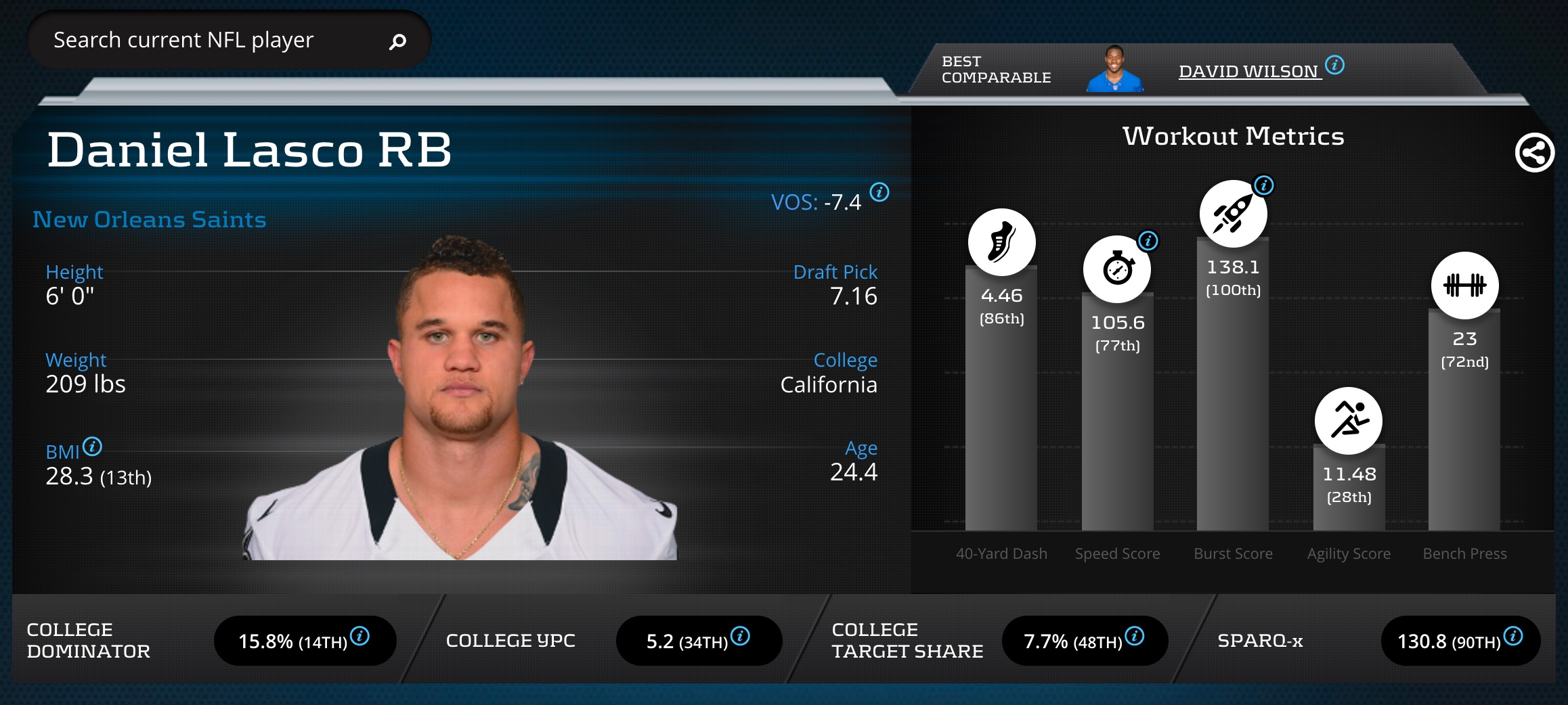
Daniel Lasco Advanced Stats & Metrics Profile
New York Giants
Sterling Shepard (WR) vs. Will Tye (TE)
Sigh. No fantasy football enthusiast is sleeping on Sterling Shepard after he posted 11.5 fantasy points per game last season behind serendipitous red zone usage. Standing 5-10, Shepard’s 10 red zone receptions (No. 12 among NFL wide receivers) will be difficult to duplicate. As a relatively old rookie tethered to a quarterback in decline, Shepard’s auxiliary possession receiver ceiling was exposed in 2016.
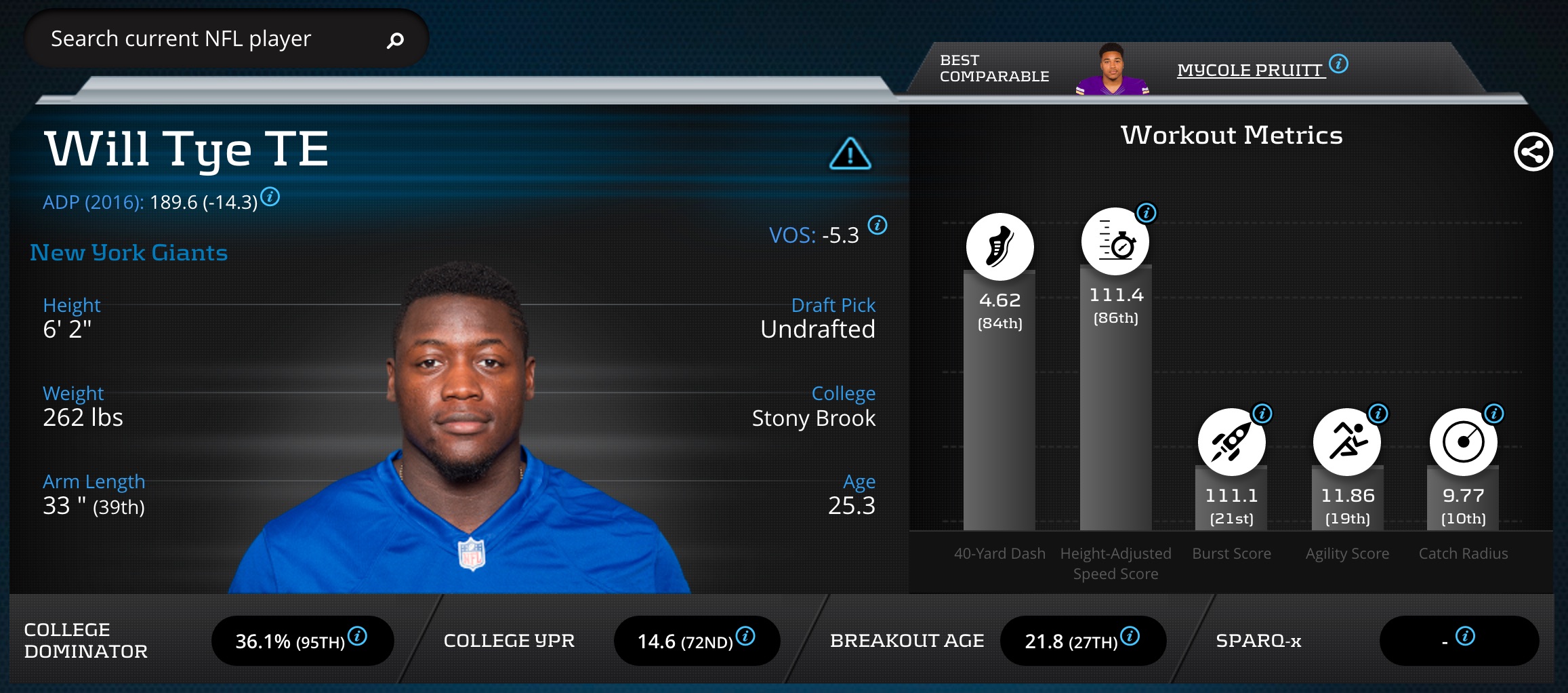
Will Tye Advanced Stats & Metrics Profile
Will Tye, on the other hand, possesses actual fantasy football upside heading into 2017. A mega-college producer featuring a 111.4 (86th-percentile) HaSS, Tye possesses the size and explosive athleticism to truly break out as the Giants primary tight end in 2017.
https://www.youtube.com/watch?v=cA9zXso7WBI
New York Jets
Austin Seferian-Jenkins (TE) vs. Robby Anderson (WR)
No objections here. Along with Erik Swoope, Austin Seferian-Jenkins is a top tight end sleeper heading into 2017. Seferian-Jenkins is an ideal dynasty league value play.
https://www.youtube.com/watch?v=1-ZcR5zihhg
Like Austin Seferian-Jenkins, Quincy Enunwa is another ideal dynasty league trade target, but like Sterling Shepard, Quincy Enunwa rose to fantasy football prominence in 2016. With Enunwa off the table, Robby Anderson looks the part of a viable late-round breakout candidate.
At 6-3, 190, Anderson’s low BMI provides precious few successful NFL wide receiver comps. However, few wide receivers boast both a 35-percent (65th-percentile) College Dominator Rating and 10.16 (78th-percentile) Catch Radius. With Brandon Marshall released, and Eric Decker and Enunwa operating close to the line of scrimmage, Anderson’s unique downfield playmaking ability should guarantee him significant snaps on the outside in 2017.
Oakland Raiders
Jalen Richard (RB) vs. DeAndre Washington (RB)
Here, RotoUnderworld and ESPN go head-to-head selecting sleeper breakout candidates at the same position for the first time, and ESPN selected poorly. As Kevin Cole outlined on RotoViz, athleticism is more predictive of NFL success for running backs than other skill positions. Jalen Richard was not a prolific college back, evidenced by a 22.6-percent College Dominator Rating, and his 82.6 (0-percentile) SPARQ-x Score suggests that he lacks the requisite athleticism to produce consistently at the NFL level.
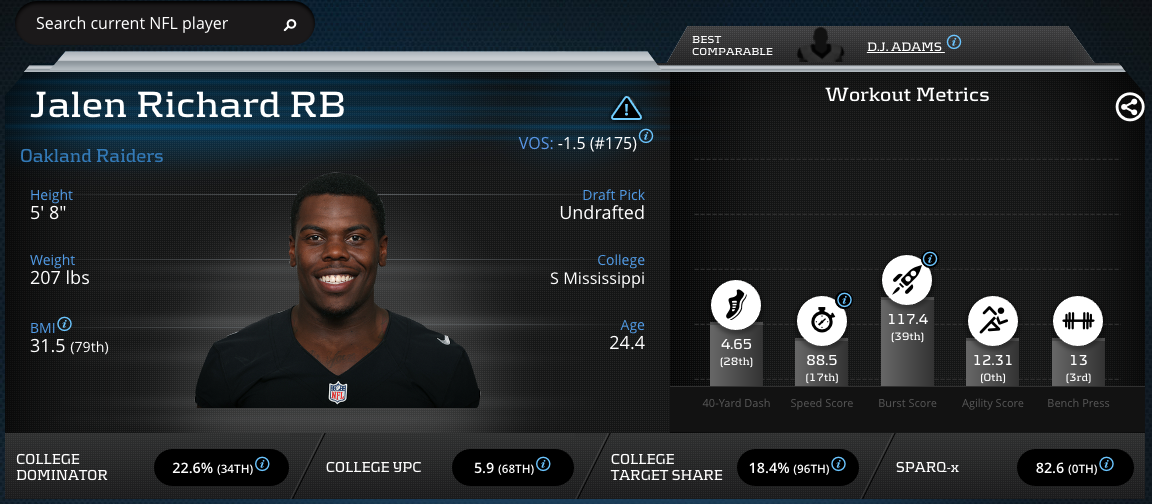
Jalen Richard Advanced Stats & Metrics Profile
With DeAndre Washington, the reverse is true. Washington posted over 1,800 all-purpose yards in his final season at Texas Tech, and then demonstrated excellent speed and strength at the NFL Scouting Combine running a sub-4.50 40-yard dash (77th-percentile) and benching 225-pounds 24 times (79th-percentile). Washington leveraged his explosiveness athleticism as a rookie with the Raiders, breaking 15-plus yard runs on more than 8-percent of his carries, a top-5 Breakaway Run Rate on PlayerProfiler. Assuming Oakland does not re-sign Latavius Murray, Washington, not Jalen Richard, should be the team’s primary running back in 2017.
Philadelphia Eagles
Carson Wentz (QB) vs. Wendell Smallwood (RB)
Carson Wentz is more likely to break out than Jared Goff in 2017 after averaging almost a full 1.0 yards per attempt more than Goff last season. Wentz impressed Eagles scouts and coaches with his arm strength and decision enough to convince the team to jettison Sam Bradford and start him over Chase Daniel in week 1 of the 2016 season. Wentz went on to post numbers similar to Derek Carr‘s lost 2014 season. Given the Eagles’ strident all-in commitment to Wentz, the organization will likely bend its will to surround him with playmakers via trade (Brandin Cooks?), free agency (Alshon Jeffery?), and/or the NFL Draft (Mike Williams?). Wentz is a legitimate sleeper breakout candidate this season.
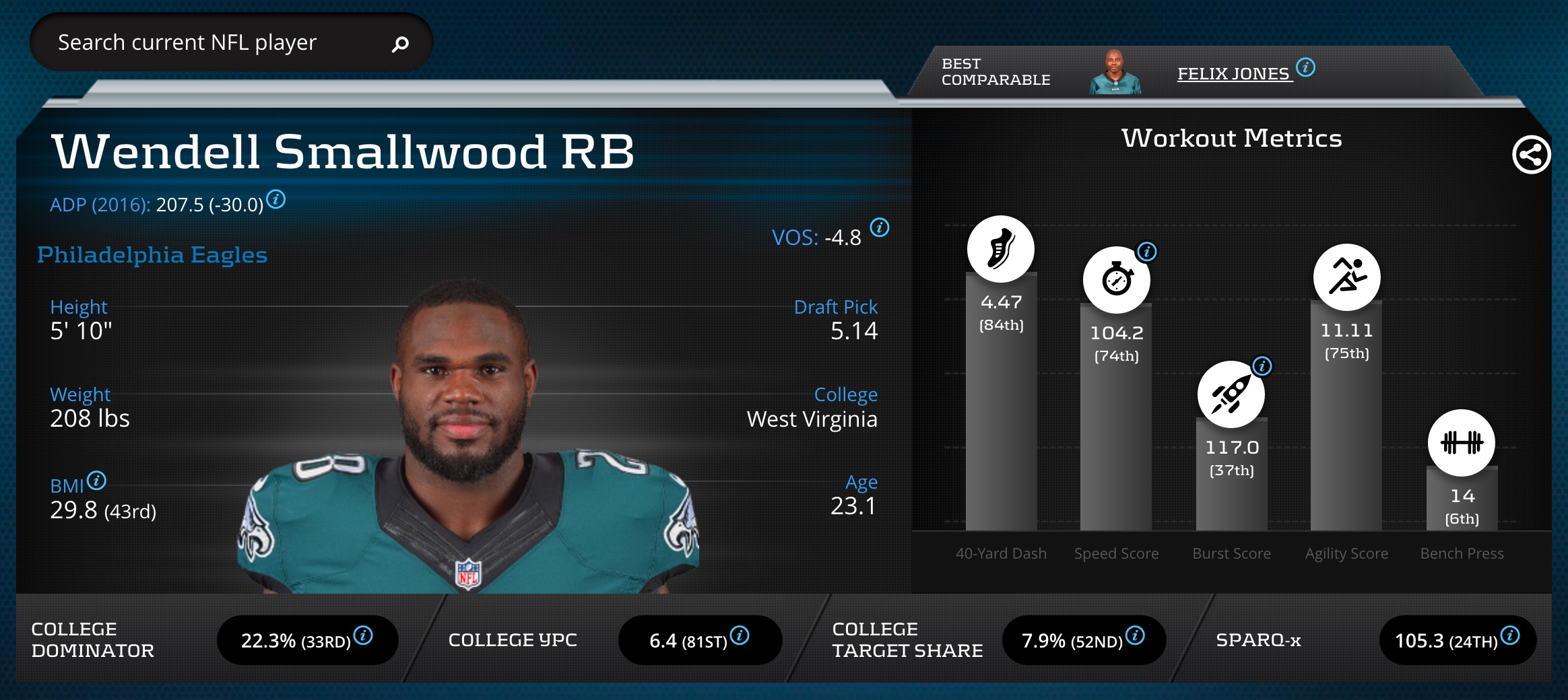
Wendell Smallwood Advanced Stats & Metrics Profile
While Wendell Smallwood also experienced a lost season in 2016, Smallwood possesses a hype-worthy athletic profile. Boasting a 104.2 (73rd-percentile) Speed Score and 11.11 (75th-percentile) Agility Score after two straight seasons with 25-plus receptions at West Virginia, Smallwood is ideally equipped to push Darren Sproles for satellite back duties in training camp.
Pittsburgh Steelers
Eli Rogers (WR) vs. Sammie Coates (WR)
Eli Rogers was my guy, and Mike Clay sunk my battleship! With excellent 10.81 (90th-percentile) Agility Score and 72.7-percent catch rate in 2017, Rogers possess the necessary hands and lateral quickness to become Ben Roethlisberger‘s Wes Welker.
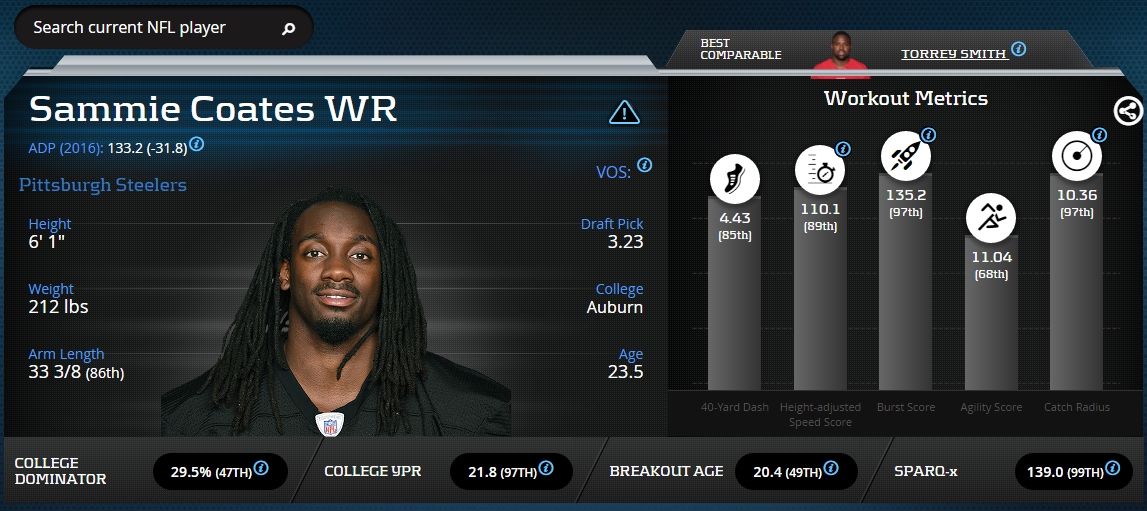
Sammie Coates Advanced Stats & Metrics Profile
While Eli Rogers’ relatively high projected target share provides a safe fantasy WR3 floor heading into 2017, Sammie Coates possesses more alluring upside. Still only 23-years old, the same age Martavis Bryant entered the NFL, Coates will be given every opportunity to convert his exceptional athleticism, evidenced by a 139.0 (99th-percentile) SPARQ-x Score, in to on-field production this season. With the Steelers now referring to Martavis Bryant in the past tense, Coates is the logical heir to Bryant’s big play field stretcher role that the Steelers sorely missed in 2016.
Steelers GM Kevin Colbert: ‘Martavis (Bryant) was a great asset to us when he was available.’
— Marc Sessler (@MarcSesslerNFL) March 1, 2017
San Diego Chargers
Hunter Henry (TE) vs. Branden Oliver (RB)
Although Hunter Henry was not a TE1 in 2016, the word is out about Henry in the fantasy football community after his posted posted 10.1 fantasy points per game. Henry was the Michael Thomas of tight ends last season, a rookie who led his position in fantasy points per game in 2016.
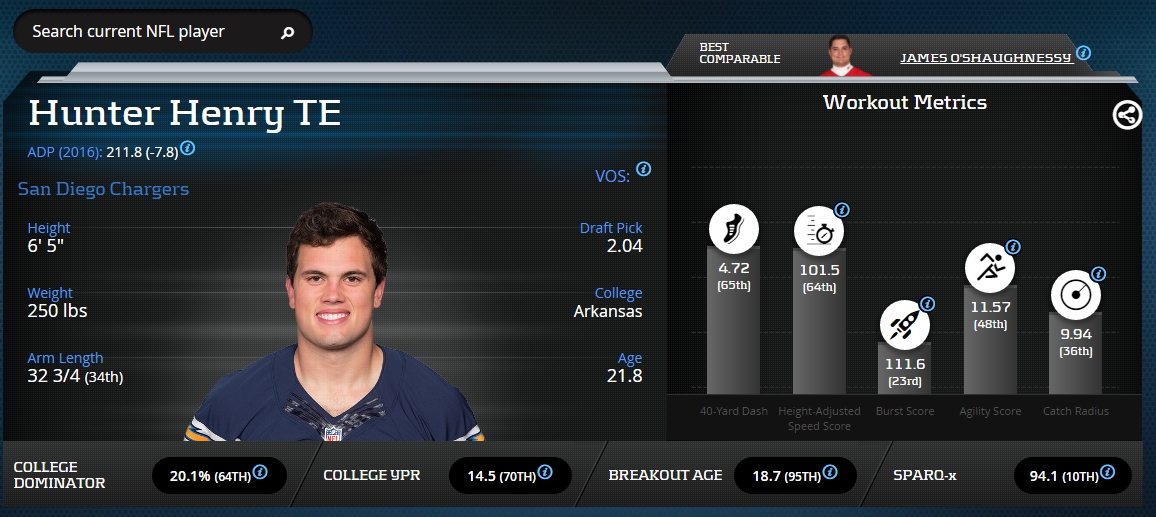
Hunter Henry Advanced Stats & Metrics Profile
Branden Oliver is the early favorite to be Melvin Gordon‘s handcuff back in 2017 after Kenneth Farrow wheezed out a mere 6.3 and 9.7 fantasy points to close out the 2016 season. Gordon ended up on injured reserve both seasons, suffering a torn knee cartilage in 2015 and a moderately severe hip strain in 2016. With Danny Woodhead set to test free agency and Gordon slated for a monster workload in 2016, Oliver is the most under-the-radar handcuff back with standalone PPR upside if Gordon falters in the passing game next season.
San Francisco 49ers
Bruce Ellington (WR) vs. Eric Rogers (WR)
I love this Bruce Ellington pick. Ellington is a bonafide sleeper breakout candidate that deserves more attention from the fantasy football community. Perfectly fits the volume slot/flanker prototype.
https://www.youtube.com/watch?v=JPWrxZF8ykE
I have a type: big, dominant, explosive wide receiver hailing non-Division I colleges and universities. Eric Rogers, the ultimate enigma, has it all. I will happily tout Rogers using the same logic as Sammie Coates: size-adjusted athleticism. Rogers’ 100.7 (70th-percentile) HaSS and 10.18 (83rd-percentile) Catch Radius make him best comparable to another stud WR banished to a demoralized franchise: Kenny Britt.
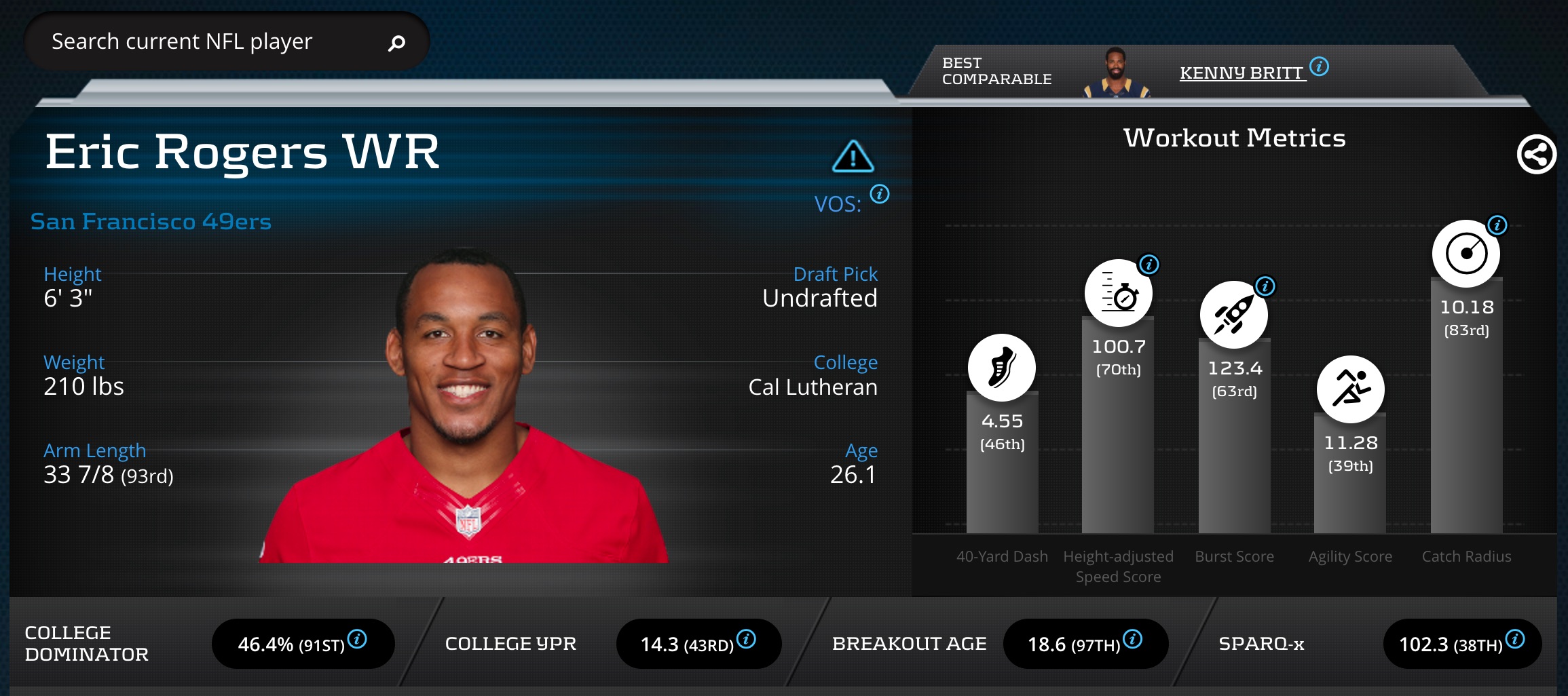
Eric Rogers Advanced Stats & Metrics Profile
While San Francisco features one of the NFL’s least efficient offenses in recent years, the 49ers’ wide receiver depth chart is also the shallowest. Assuming that San Francisco is unable to woo one of the NFL’s premiere free agent wide receivers this offseason, Rogers will compete with mega-bust Torrey Smith, unproven Bruce Ellington, and perennial underachiever Quinton Patton for targets in 2017.
Seattle Seahawks
Tyler Lockett (WR) vs. Paul Richardson (WR)
The word was out on Tyler Lockett when his ADP rose into round 6 after Matt Harmon touted Lockett as the next Allen Robinson.
tyler lockett is the next allen robinson after all.
— the podfather (@Fantasy_Mansion) October 24, 2016
Paul Richardson on the other hand is still unknown to the average fantasy gamer, yet his profile is equally impressive. Richardson was an early pick in the 2014 NFL Draft after posting a 46.3-percent (90th-percentile) College Dominator Rating and a 4.40 (93rd-percentile) 40-yard dash time. Richardson’s relatively long arms and vertical explosion fueled his 10.14 (73rd-percentile) Catch Radius, exceptional for a smaller receiver. With Tyler Lockett rehabilitating multiple leg fractures, Richardson will battle Lockett for Seattle’s “stretch-X” outside receiver role in 2017.
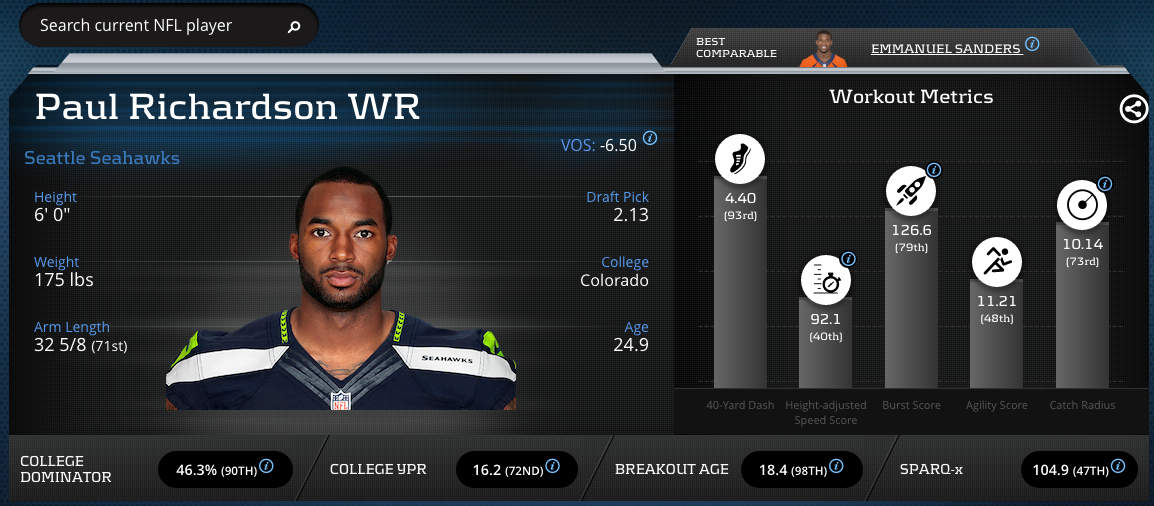
Paul Richardson Advanced Stats & Metrics Profile
Tampa Bay Buccaneers
Adam Humphries (WR) vs. Jameis Winston (QB)
Adam Humphries is the prototypical replacement level NFL slot receiver. In 2016 he was just a guy who knew the system while his teammates fell down around him.
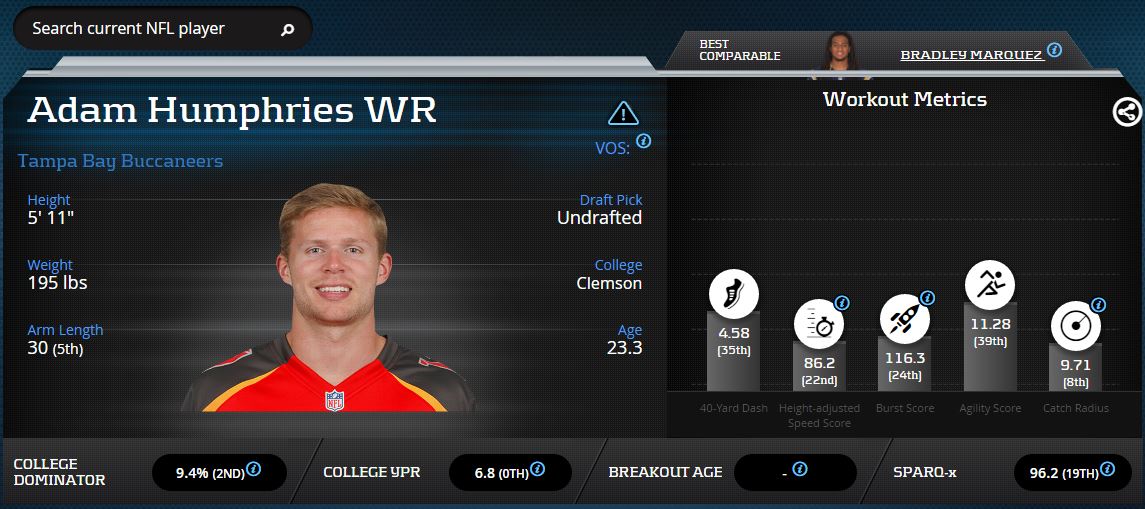
Adam Humphries Advanced Stats & Metrics Profiles
Jameis Winston is anti-Adam Humphries. One of the highest pedigreed prospects in NFL Draft history, former National Champion and Heisman Trophy award winner Jameis Winston’s volume and efficiency rose in 2016. Boasting a 60-percent (No. 25) completion percentage, Winston may always be Eli Manning to Marcus Mariota‘s Philip Rivers, but like Manning, Winston is a fearless downfield thrower.
Jameis Winston‘s volume should rise in 2017 as he continues to acclimate to NFL defensive schemes and gain his coach’s trust at 23-years old. Doug Martin is departing after Tampa Bay ranked No. 25 in the NFL in team rushing yards last season, and the Buccaneers will likely feature one of the NFL’s weakest running games again in 2017 and one of the best WR corps headlined by Mike Evans. Winston projects to finish 2017 as a volume-fueled fantasy QB1.
Tennessee Titans
Derrick Henry (RB) vs. Tajae Sharpe (WR)
Derrick Henry is a special player. Hell, his best comparable player on PlayerProfiler is Zangief. If DeMarco Murray gets injured, Henry would be a fantasy RB1 running behind Tennessee’s elite run blocking offensive line. However, as long as Murray is healthy, Henry will remain one of the NFL’s highest ceiling handcuffs.
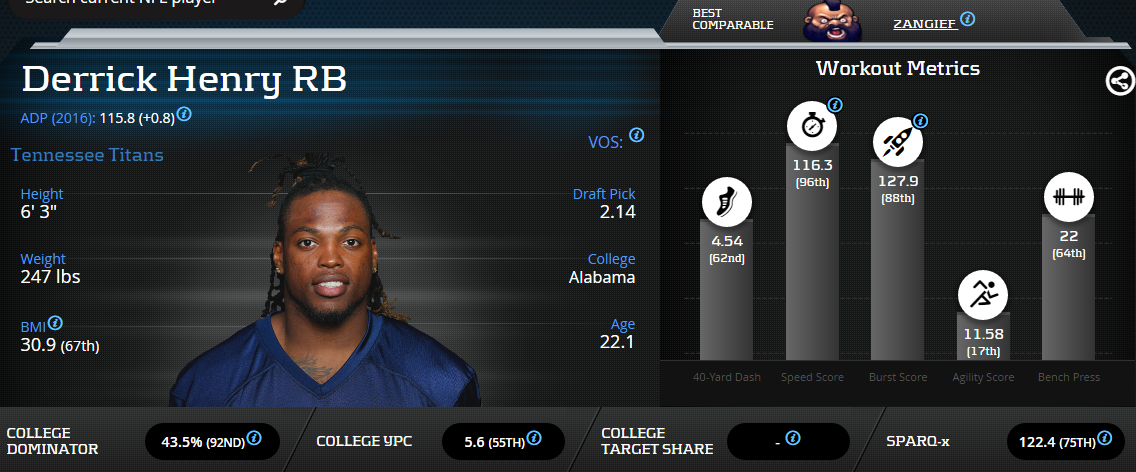
Derrick Henry Advanced Stats & Metrics Profile
Tajae Sharpe, on the other hand, led the Titans in snap share at age 21. Let that sink in. After dominating at an early age at UMass, Sharpe won a starting role with one of the most impressive training camp performances, before NFL defenses overwhelmed him during the season.
Heading into his age-22 sophomore NFL season, Sharpe’s impressive prospect profile, which features a 37.8-percent (72nd-percentile) College Dominator Rating and 18.7 Breakout Age (94th-percentile) indicates he is an ideal breakout candidate. Incumbent No. 1 receiver Rishard Matthews profiles as a complementary NFL possession receiver. Sharpe is poised to supplant him (again) in training camp this season and become the team’s primary slot/flanker and target share leader.
Washington
Josh Doctson (WR) vs. Niles Paul (TE)
I just won a bet. Josh Doctson possesses an exceptional athletic profile, but the list of NFL wide receivers who break out after a lost rookie season is miniscule. Doctson is already 24-years old, and it would be an upset if he suddenly supplants Jamison Crowder on Washington’s target totem pole.
https://www.youtube.com/watch?v=IJYOK1Wt_SI&t=4s
Niles Paul‘s path to fantasy relevance is much easier than the average fantasy gamer may believe. Never forget: Paul usurped Jordan Reed securing Washington’s starting tight end role two years ago. Perpetual concussions have since thrown Reed’s ability to play football into permanent jeopardy.
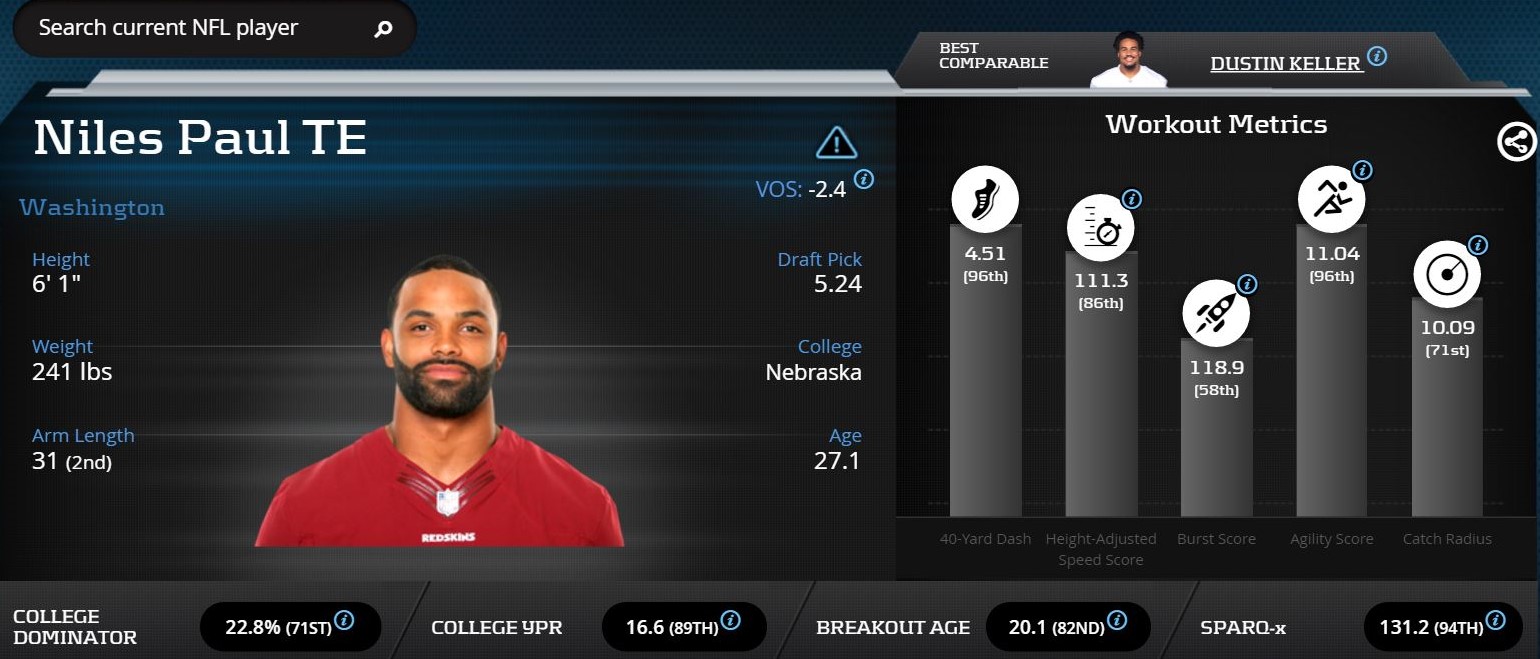
Niles Paul Advanced Stats & Metrics Profile
If Jordan Reed is unable to play football in 2017, Niles Paul would become a featured passing game weapon on a soon-to-be-vacated Washington receiving corps. Washington accumulated 630 (No. 8) pass attempts, and with Le’Veon Bell franchise tagged, there is little hope of reviving Washington’s inept running game. Demonstrating exceptional athleticism at every level of football, evidenced by a 131.2 (95th-percentile) SPARQ-x Score, Paul is positioned to convert significant volume into prolific production in 2017, and no one realizes it.


